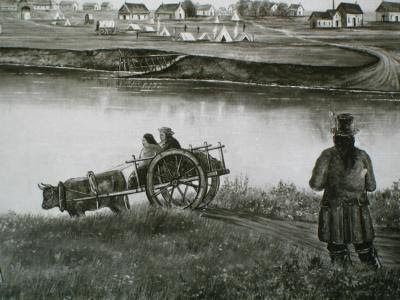
York Boats and Red River Carts
Early Transportation in Manitoba
by George Siamandas
Early Transportation in Manitoba
by George Siamandas
Manitoba's first highways were lakes, rivers and streams. Two modes of transportation that were common in this area through most of the 1800s were the Red River Carts and the York boats. The vehicle indigenous to the area is the Red River Cart. First introduced around 1801, this famous symbol of the prairies operated until the late 1800s. They were used in moving settlers, and in the buffalo hunt. Literally hundreds of Red River carts would bring furs to market and take back the commercial goods of the day. About 2,500 carts were still doing the route to St. Paul Minnesota as late as 1869.
Apparently the carts could never sneak up on anyone. It is said that you could hear the carts long before you could see them. And there was an ever present cloud of dust whenever the trail was not muddy. If you tried to grease the wheels, dust would gather jamming up the works. As a result, travellers learned to do without grease. Those that used them had to be able to build and repair them. And most were built from whatever wood was growing along the riverbanks. All you needed was an axe, a saw, a drawknife and a screw auger. No iron was used because everything was held together with dowels. And of course oxen did the work of pulling them along. Each cart could carry about 1,200 pounds. It took a day to go from the Forks to Lower Fort Garry.
The carts were very versatile and could even get across water, by placing animal hides over the wheels giving sufficient flotation. The carts also provided a measure of protection from Indian attacks. In 1851, 83 Red River Metis withstood a 2 day attack by 2,500 Sioux warriors on the banks of the Missouri River. The Metis of St. Francis Xavier (originally called Grantown) were well known builders of the Red River carts and charged $10 for a cart. The wood of choice was Manitoba maple or oak. The first ones had solid wheels about 3 feet across while later ones had spoked wheels. The coming of the railways put an end to the Red River Carts. Three original carts are known to exist. One is at the Museum of Man and Nature, another at Lower Fort Garry and a third at a shopping centre in Emerson.
YORK BOATS
From Fort Garry, York Boats would take over as the mode of transport north. The York boats were built by Bay employees from spruce and were typically 30-40 feet long. The first ones are thought to have been built around 1780. The York boat was modelled on the Orkney whaleboater. It took 20 days to build and weighed a ton. A crew of 10 or 11 men would ply heavy 20 foot oars. The York boats could carry goods weighing up to 8-9 tons. It was hard work for the men that rowed from dawn to dusk at 30 strokes per minute. When they got into open water they could put up a sail. The York boats were the mainstay for the Hudson Bay company and could move people and goods as far away as the Pacific and Arctic oceans. For portaging the men would pull the York boats over wooden rollers and in shallow water they used poles to make progress. York boats were used until the steamers took over in the late 1850s. Real examples can be seen at Lower Fort Garry.












No comments:
Post a Comment